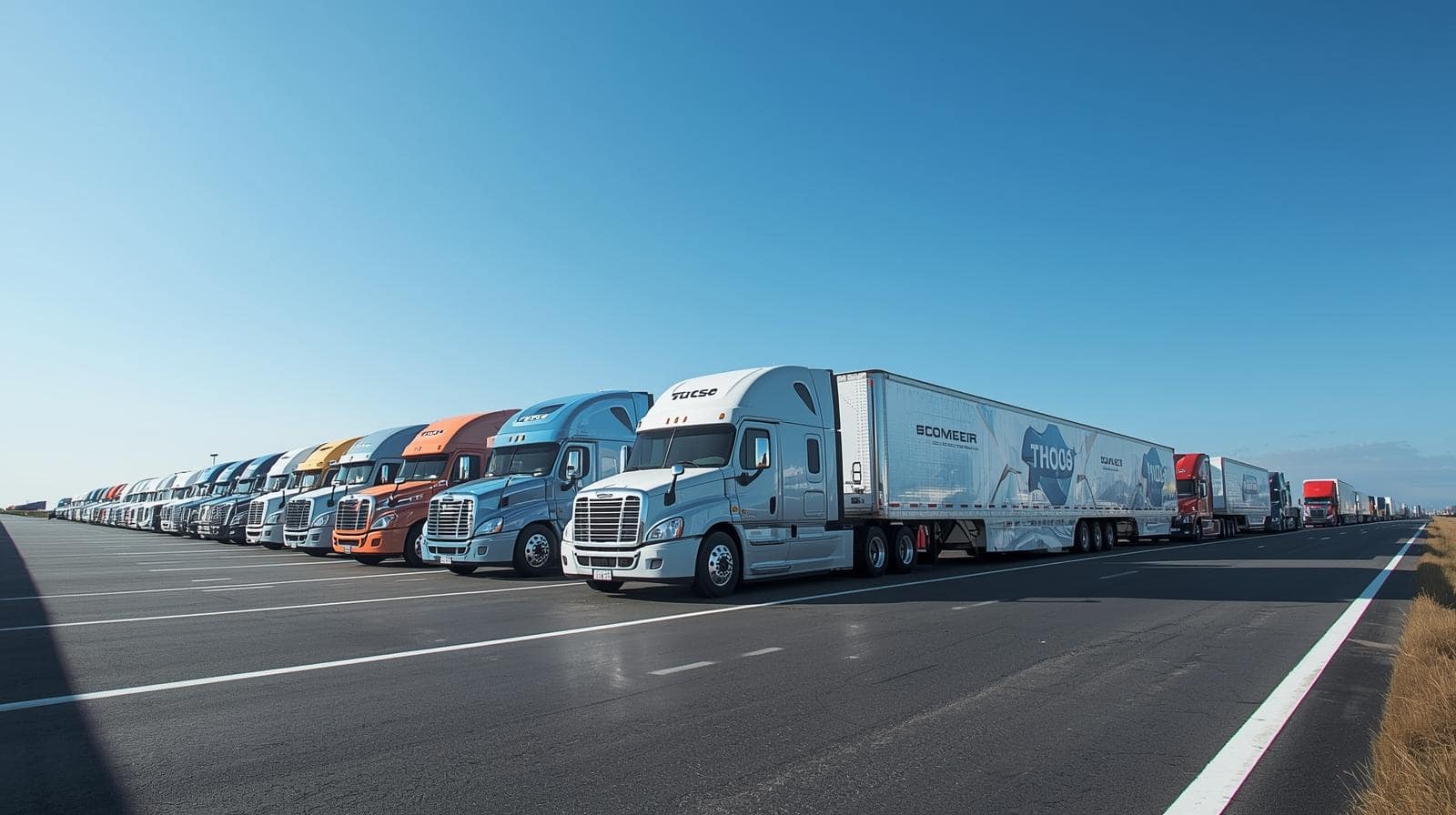In today’s competitive transportation industry, effective fleet management is key to running a successful business. Whether you are a small trucking company or a large fleet operator, leveraging advanced technologies like truck fleet data analytics can significantly enhance operational efficiency, reduce costs, and improve decision-making processes. The continuous rise of data in fleet operations has introduced new ways to optimize performance and gain deep insights into vehicle management, driver behavior, and overall fleet efficiency.
In this comprehensive article, we will explore the different aspects of fleet management data analytics, the role of big data analytics in fleet management, and how data-driven fleet analytics can revolutionize the way fleet managers optimize operations and boost efficiency.
Fleet Management Data Analytics
Fleet management data analytics refers to the collection, processing, and analysis of data generated by trucks, drivers, and other assets within a fleet. This data is used to monitor performance, predict maintenance needs, track fuel consumption, and improve the overall efficiency of fleet operations.
The key to success in fleet management is the ability to make data-driven decisions. With truck fleet data analytics, fleet managers can access real-time insights that help in minimizing downtime, optimizing routes, improving safety standards, and even reducing carbon emissions.
Key Components of Fleet Management Data Analytics
- Telematics Systems: These systems provide real-time data from vehicles, including speed, location, fuel consumption, and engine performance. This data is essential for fleet managers to monitor fleet health and make timely decisions.
- Driver Behavior Monitoring: Data analytics helps monitor drivers’ behavior by tracking metrics such as braking patterns, acceleration, idling time, and seatbelt usage. These insights allow fleet managers to implement training programs, improving safety and fuel efficiency.
- Maintenance and Repairs: By tracking vehicle health and usage patterns, fleet data analytics can predict when a vehicle is due for maintenance or may require repairs. Preventive maintenance, based on real-time data, helps avoid costly breakdowns and increases fleet uptime.
- Route Optimization: Analyzing fleet data helps optimize routes, ensuring the fastest, safest, and most fuel-efficient paths for drivers. With optimized routes, fleet managers can cut down on fuel costs, reduce delivery times, and enhance customer satisfaction.
Benefits of Fleet Management Data Analytics
- Reduced Operational Costs: Data analytics helps identify inefficiencies in the fleet, from excessive fuel consumption to unnecessary vehicle idle times, leading to significant cost savings.
- Improved Safety: By monitoring driver behavior, fleet managers can pinpoint risky driving habits and implement corrective measures. This reduces the likelihood of accidents and ensures the safety of both drivers and cargo.
- Enhanced Decision-Making: Data analytics allows fleet managers to make informed decisions based on real-time insights, improving operational effectiveness.
In summary, truck fleet data analytics provides valuable insights that can improve nearly every aspect of fleet management. From tracking maintenance needs to optimizing routes, data is a crucial tool in reducing costs, improving safety, and increasing fleet efficiency.
Fleet Data Analytics
Fleet data analytics goes beyond basic fleet management by providing a broader range of insights into various facets of fleet operations. This field encompasses the collection, analysis, and application of data to optimize the entire fleet system, from vehicle performance to workforce management.
How Fleet Data Analytics Works
Fleet data analytics operates on the premise that every vehicle, driver, and operational aspect generates data that can be analyzed to uncover patterns, inefficiencies, and opportunities for improvement. Key types of fleet data include:
- Vehicle Tracking: GPS tracking enables fleet managers to monitor the location, speed, and movement of each vehicle in real time. The data is used to improve route planning, reduce idle times, and enhance vehicle utilization.
- Fuel Consumption Analysis: With fleet data analytics, companies can track fuel consumption patterns across their fleet. This helps identify factors contributing to fuel inefficiency, such as poor driver behavior, route choices, or vehicle maintenance issues.
- Maintenance Records: The analysis of maintenance records allows fleet managers to predict vehicle failures before they occur. Proactive maintenance scheduling leads to fewer breakdowns and reduces the costs associated with emergency repairs.
- Driver Performance Monitoring: Data analytics tools track driver performance, including speed, braking, cornering, and acceleration. Understanding driver behavior can lead to targeted training that improves fuel economy and reduces the risk of accidents.
Benefits of Fleet Data Analytics
- Cost Reduction: By tracking key performance indicators such as fuel usage, maintenance costs, and idle times, fleet managers can identify areas where costs can be reduced.
- Improved Fleet Utilization: With detailed data analysis, fleet managers can identify underutilized vehicles or identify overused trucks that may require additional support or maintenance.
- Better Compliance and Reporting: Data analytics enables fleet managers to keep up with regulations and compliance requirements, including hours of service regulations, safety standards, and environmental laws.
- Enhanced Customer Satisfaction: With optimized routes and schedules, customers can receive their goods more quickly and reliably. This enhances overall customer satisfaction and loyalty.
Fleet data analytics is the backbone of an optimized fleet operation. By understanding the full scope of fleet activities and using data to drive decisions, companies can enhance productivity, reduce costs, and boost overall operational efficiency.
Big Data Analytics in Fleet Management
Big data analytics in fleet management refers to the large volumes of data generated by modern fleets that can be processed and analyzed to improve efficiency. This data includes everything from vehicle telemetry to driver behavior, and even environmental data such as weather conditions.
How Big Data Analytics Works in Fleet Management
Big data analytics involves the collection and analysis of massive datasets, typically in real time, to identify trends, patterns, and potential issues in fleet operations. Big data tools can process these datasets and generate actionable insights for fleet managers.
Some common sources of big data in fleet management include:
- Vehicle Telematics: Real-time data from GPS devices and onboard sensors can track vehicle performance, fuel consumption, engine health, and more.
- Driver Data: The collection of driver behavior data, including braking, speeding, idling, and other metrics, is crucial for improving safety and performance.
- Weather and Traffic Data: By analyzing weather conditions and real-time traffic data, fleet managers can optimize routes to avoid delays and fuel waste.
- Fuel Consumption Data: Big data tools can track fuel consumption patterns across the fleet, allowing managers to identify inefficiencies and take corrective actions.
Benefits of Big Data Analytics in Fleet Management
- Predictive Maintenance: By analyzing historical data, big data tools can predict when a vehicle will need maintenance, which reduces downtime and prevents expensive repairs.
- Operational Efficiency: By integrating and analyzing data from multiple sources, fleet managers can improve decision-making, optimize routes, and enhance fuel efficiency.
- Fleet Optimization: Big data allows fleet managers to make more informed decisions regarding vehicle usage, driver assignments, and maintenance schedules.
- Risk Management: Big data analytics helps identify patterns in driver behavior, which can help improve safety protocols and reduce accidents. Fleet managers can implement training programs based on data-driven insights, leading to safer driving habits.
Big data analytics in fleet management is transforming the industry by offering insights that were previously unavailable. Through the use of large datasets and advanced algorithms, fleet managers can optimize operations, reduce costs, and improve safety, all while boosting overall fleet performance.
Data Analytics in Fleet Management
Data analytics in fleet management is the use of data to drive decisions that improve fleet performance. This can include everything from improving fuel efficiency to enhancing driver safety and ensuring vehicles are running at optimal performance.
Data analytics tools allow fleet managers to analyze large amounts of data collected from various sources, such as telematics, vehicle sensors, and driver behavior monitors. This data is then used to create actionable insights that inform operational decisions.
The Role of Big Data Analytics in Fleet Management
Big data analytics in fleet management is integral to making sense of the complex, high-volume data that modern fleets generate. The ability to process and analyze data from different sources allows fleet managers to uncover inefficiencies and optimize operations.
For instance, big data analytics can help predict when a vehicle is due for maintenance or flag a potential issue based on trends observed in vehicle performance data. Similarly, analyzing driver behavior data can lead to more targeted training programs, improving safety and reducing operational costs.
Data Analytics Tools in Fleet Management
Some common tools used in fleet management data analytics include:
- Telematics Systems: These systems provide real-time data on vehicle performance, location, fuel consumption, and driver behavior.
- Fleet Management Software: This software allows fleet managers to track vehicle maintenance, manage fuel costs, and optimize routes based on data analytics.
- Mobile Apps: Fleet managers use mobile apps to monitor driver performance, track deliveries, and ensure compliance with regulations in real time.
- Data Dashboards: Data dashboards allow fleet managers to visualize key performance metrics, making it easier to track performance and identify areas for improvement.
The Future of Data Analytics in Fleet Management
As the fleet industry continues to evolve, the future of data analytics in fleet management looks promising. Advances in artificial intelligence (AI), machine learning (ML), and the Internet of Things (IoT) will enable fleets to operate more efficiently, improve safety, and enhance customer service.
- AI and ML: These technologies can analyze vast amounts of data to identify patterns, predict maintenance needs, and optimize routes.
- IoT Integration: IoT sensors will allow for more granular data collection, enabling even better fleet management and predictive maintenance.
Data analytics in fleet management provides fleet managers with the tools they need to optimize operations, reduce costs, and boost efficiency. With real-time data and actionable insights, fleets can continuously improve performance and stay competitive in a fast-changing industry.
Data Driven Fleet Analytics
Data driven fleet analytics is the process of using data to make strategic decisions that enhance fleet operations. This approach is based on the premise that data, when analyzed correctly, can provide valuable insights that lead to more informed decision-making.
How Data Driven Fleet Analytics Works
Data-driven fleet analytics uses data from various sources, such as telematics, GPS tracking, fuel consumption, and maintenance records, to identify opportunities for improvement. By processing this data, fleet managers can optimize everything from vehicle utilization to fuel efficiency and driver performance.
Some examples of how data-driven fleet analytics is used include:
- Fuel Efficiency Optimization: By analyzing fuel consumption patterns, fleet managers can identify inefficiencies, such as excessive idling or inefficient driving routes, and take corrective action to reduce fuel costs.
- Driver Behavior Improvement: By tracking driver behavior, such as speeding, harsh braking, and excessive idling, fleet managers can implement targeted training programs that improve safety and reduce wear and tear on vehicles.
- Maintenance Optimization: By analyzing vehicle performance data, fleet managers can predict when a vehicle is likely to require maintenance or repairs, ensuring that vehicles remain operational for longer and minimizing costly downtime.
- Route Optimization: Data-driven fleet analytics helps optimize delivery routes by considering traffic conditions, fuel efficiency, and time of day. By reducing fuel consumption and improving delivery times, fleets can save money and improve customer satisfaction.
Benefits of Data Driven Fleet Analytics
- Improved Efficiency: Data-driven analytics helps identify inefficiencies in fleet operations, from fuel consumption to driver behavior, leading to improved overall performance.
- Cost Savings: By using data to optimize routes, improve fuel efficiency, and predict maintenance needs, fleet managers can significantly reduce operational costs.
- Proactive Decision-Making: Data-driven fleet analytics provides fleet managers with real-time insights, allowing for proactive decision-making that improves safety, performance, and efficiency.
- Better Visibility and Control: By using data analytics tools, fleet managers gain greater visibility into every aspect of their fleet operations, allowing them to make more informed decisions and take corrective action when needed.
Data-driven fleet analytics is transforming the way fleets operate, providing fleet managers with the insights needed to reduce costs, improve efficiency, and enhance overall fleet performance.
Contact Ezlogz
Are you ready to optimize your fleet operations and boost efficiency? At Ezlogz, we provide state-of-the-art truck fleet data analytics tools that help you monitor, analyze, and optimize your fleet for maximum performance.
Contact us today to learn more about how our data-driven solutions can help your fleet reach new heights of efficiency and profitability.










